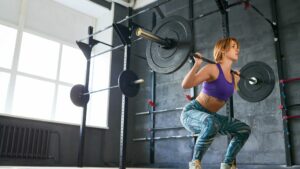
Misconception might
The misconception might arise from the fact that squats can build muscle mass in the glutes, hips, and thighs, giving the illusion of a larger waist due to the contrast in size. But this isn’t an actual increase in waist size; rather, it’s an enhancement of the surrounding muscle groups.
The key to understanding changes in body size due to exercise is considering multiple factors. Nutrition, genetics, overall exercise routine, and specific goals all play roles in shaping your body’s response to workouts like squats.
How Squats Affect the Body
Targeted Muscles
Squats primarily target large muscle groups like:
Quadriceps: Front thigh muscles.
Hamstrings: Back thigh muscles.
Glutes: Buttocks muscles.
Core: Abdominals and lower back muscles for stabilization.
Waist Size Impact
While squats indirectly engage the core muscles, they aren’t a direct contributor to increasing waist size. Instead, they promote overall strength and stability, potentially enhancing your posture and creating a more sculpted appearance around the midsection.
Factors Influencing Body Changes
Diet
A balanced diet that supports muscle growth and fat loss can complement your workout efforts. It helps in defining muscles and reducing overall body fat, contributing to a more toned physique.
Genetics
Individual genetic predispositions play a significant role in how muscle responds to exercise. Some individuals might build muscle more easily in certain areas than others.
Complete Exercise Routine
Squats should be part of a comprehensive workout regimen that includes various exercises targeting different muscle groups. This holistic approach ensures balanced muscle development.
So.
In summary, while squats primarily focus on lower body strength and muscle development, they contribute to overall body strength and posture. When done in conjunction with a well-rounded fitness routine and a balanced diet, they can enhance muscle definition and contribute to a more toned appearance, including the midsection.
Remember, the impact of squats on waist size is more about creating a balanced and strong physique rather than directly increasing the waistline.
Myth Busting: Squats and Waist Size
Misconceptions
The misconception about squats increasing waist size often stems from a misunderstanding of muscle development and body composition. Some individuals might notice changes in their waistline due to various factors, but attributing it solely to squats might overlook other aspects of their fitness routine or diet.
Muscle Development vs. Waist Size
Squats primarily target the lower body muscles, promoting muscle growth and strength. However, for the waistline to visibly increase in size due to squats alone, there would need to be a significant increase in muscle mass or fat around the waist area. This scenario is unlikely as squats predominantly engage the lower body muscles.
Core Engagement
Squats engage the core muscles for stabilization but don’t focus on isolating the waistline. Instead, they promote a strong core, which can improve posture and contribute to a more defined midsection. However, a narrower waist might appear due to improved muscle tone and reduced body fat, not necessarily an increase in size.
Optimizing Squats for Results
Proper Form
Executing squats with proper form is crucial for optimal results and safety. Maintaining alignment, controlling the movement, and avoiding excessive weight can ensure that you target the intended muscle groups without risking injury.

Variations and Progression
Exploring different squat variations, such as goblet squats, sumo squats, or front squats, can challenge the muscles in varying ways, contributing to a well-rounded lower body workout. Additionally, gradually increasing weights or reps can aid in muscle growth and strength development.
Comprehensive Training
While squats offer numerous benefits, incorporating a diverse range of exercises targeting different muscle groups ensures a balanced physique. Combining squats with exercises for the upper body, core, and cardiovascular fitness contributes to overall health and fitness.
Final Thoughts
Squats are a fantastic compound exercise known for their effectiveness in building lower body strength and muscle. When performed correctly and as part of a holistic fitness routine, they contribute to a strong, toned physique. However, attributing changes in waist size solely to squats might oversimplify the complexities of body composition and fitness.
Remember, achieving fitness goals involves a multifaceted approach that includes a balanced diet, varied workouts, and consistency. Embrace the benefits of squats while appreciating their role in a comprehensive fitness journey.
External Resources:
Fitness Blender: 9 Best Squat Variations for Beginners
Comparison tabular
| Aspect | Squats and Waist Size |
|---|---|
| Muscles Targeted | Primarily lower body muscles – quadriceps, hamstrings, glutes, with core muscles engaged for stabilization. |
| Direct Impact on Waist Size | Squats don’t directly increase waist size; they contribute to overall strength, muscle development, and core stability. |
| Core Engagement | Engages core muscles as stabilizers, promoting better posture and a potentially more defined midsection. |
| Visible Changes in Waistline | Can create a more toned appearance around the waist due to improved muscle tone and reduced body fat, not size increase. |
| Influence on Body Composition | Helps in building muscle and strength, contributes to a balanced physique when part of a comprehensive workout routine. |
| Myth vs. Reality | Misconception exists about squats directly increasing waist size; changes are more about muscle tone and overall fitness. |
This comparison table outlines the relationship between squats and waist size, emphasizing their impact on muscle development, body composition, and the common misconceptions associated with their effects on the waistline. Squats, when incorporated into a well-rounded fitness regimen, offer a plethora of benefits for overall strength and muscle development without significantly impacting waist size directly.
Wrapping up
In the world of fitness, squats stand as a cornerstone exercise, revered for their ability to sculpt and strengthen the lower body. While the association between squats and waist size might raise questions, it’s crucial to understand their true impact.
Squats primarily target leg muscles while engaging the core for stabilization. They contribute to a stronger, more defined physique overall, potentially enhancing the appearance of the midsection through improved muscle tone and better posture.
Remember, attributing changes in waist size solely to squats oversimplifies the complex interplay of exercise, genetics, and nutrition in shaping our bodies. A comprehensive approach to fitness, including diverse exercises and a balanced diet, is key to achieving holistic results.
Embrace squats for their incredible benefits but appreciate that a sculpted waistline is a culmination of various fitness components working together harmoniously. Stay consistent, stay informed, and enjoy the journey to a fitter, stronger you!

Hey there, it’s Mike Rrsq, the Editor-in-Chief over at Jsquat.com, and I’m absolutely obsessed with all things squat fitness! I’ve been lucky enough to get some serious recognition for my work in this field. With a solid background in the fitness and wellness industry, I’ve been there right from the get-go, helping shape this website into what it is today.
You see, I’m not just the boss around here; I’m also a passionate contributor. I love sharing my insights through my articles, and trust me, they’re not your run-of-the-mill stuff. Each piece I write is a labor of love, filled with my expertise and real-world experience in the fitness universe. So, if you’re into fitness and looking for some inspiration, you’re in the right place!
Related Posts
- Could Daily Squats Lead to Sciatica and Indicate a Muscle Imbalance? Let's Investigate
Are you one of those fitness enthusiasts who took up squatting every day, only to…
- Should you use weights while squatting for toning purposes.
Absolutely. incorporating weights into your squat routine can be incredibly beneficial when toning your muscles.…
- Is 50 Squats in a Row Good? Benefits and Risks of Squatting
Performing 50 squats in a row can be a great achievement for many people, indicating…
- Are Slow Squats Effective? (Explained)
Discover the truth about slow squats and their effectiveness in building leg strength. Read on…
- 6 important Reasons Why To Do Squats (Explained)
Hey there, fitness enthusiast. Are you ready to take your workouts to the next level?…
- Are Squats The Best to Get Bigger Legs?(Explained)
Squats have long been regarded as one of the best exercises to build bigger, stronger…
- Is there truth to the belief that squatting daily for an extended period can lead to knee issues
Squats, renowned for their ability to sculpt powerful legs and strengthen the lower body, have…
- Why Do Squats Make Me Sore The Next Day: Explained)
You've just completed a challenging squat workout, and now you're left with sore muscles the…
